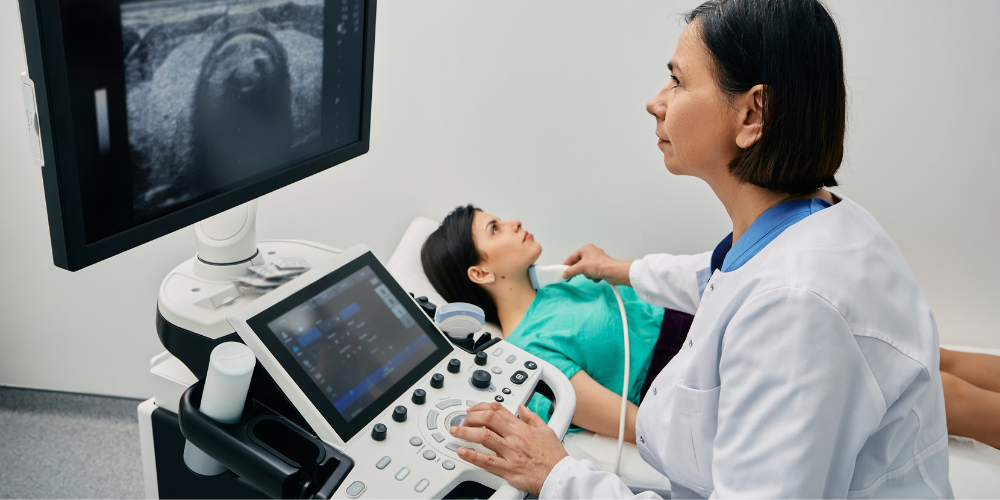The integration of artificial intelligence (AI) into medical imaging has introduced transformative possibilities for diagnostic accuracy and workflow optimization. One notable advancement in this realm is ChatGPT-4, a large language model developed by OpenAI.
Recent studies have showcased its capabilities in analyzing and interpreting thyroid ultrasound images, suggesting potential applications in radiology. This week's edition of Ultrasound Today provides an in-depth review of some key studies evaluating ChatGPT-4's performance in thyroid ultrasound analysis.
A recent study published in Radiology Advances delves into the potential of ChatGPT-4 in analyzing thyroid and renal ultrasound images. Led by Dr. Laith Sultan at Children’s Hospital of Philadelphia, the research suggests that ChatGPT-4 showcases impressive accuracy in tasks such as image segmentation and lesion classification.
These findings hint at possible advantages for radiological workflows, as the tool might aid in pre-screening and categorizing ultrasound images, potentially enhancing ultrasound image interpretation and healthcare outcomes.
To evaluate ChatGPT-4's capabilities, the study employed two distinct tests focused on analyzing thyroid ultrasound images. In the first test, researchers tasked ChatGPT-4 with identifying and marking lesions on ultrasound images, along with providing a differential diagnosis for the identified nodules.
Remarkably, ChatGPT-4 successfully completed this task, accurately outlining lesions and offering differential diagnoses. Furthermore, in a separate test, ChatGPT-4 was challenged to distinguish between images with normal findings and those displaying abnormalities. The model demonstrated high accuracy in classifying cases and furnished detailed descriptions of findings and diagnoses.

However, despite the optimism surrounding ChatGPT-4 the study has sparked discussions concerning its limitations and avenues for improvement. Dr. Woojin Kim, a musculoskeletal radiologist and Chief Medical Information Officer at Rad AI, challenged the conclusions of the study on ChatGPT-4's performance, particularly questioning the significance of the claimed breakthrough and the validity of the findings.
Expressing his disagreement with the authors, Dr. Kim highlighted concerns about the study's small sample size and the limited scope of evaluation, suggesting that a more extensive and diverse dataset would provide a more accurate assessment of ChatGPT-4's capabilities.
Given the skepticism about the small sample size, could a study with over 1,000 images offer more convincing results? This sets the stage for our next investigation.
A retrospective study published in Radiology in March 2024 aimed to enhance consistency and accuracy in diagnosing thyroid nodules using ultrasound imaging by integrating large language models (LLMs) into the diagnostic process.
Assessing 1,161 pathologically diagnosed thyroid nodule images, the study found ChatGPT-4 to exhibit satisfactory reproducibility. ChatGPT-4 excelled in both the human-LLM interaction and image-to-text–LLM strategies, achieving an accuracy of 78%–86%.

The investigation focused on evaluating three LLMs—ChatGPT-3.5, ChatGPT-4, and Google Bard—and their agreement in diagnosing thyroid nodules based on standardized reporting criteria. Intra-LLM agreement analysis revealed substantial to almost perfect agreement for ChatGPT-4 and Bard, while ChatGPT-3.5 showed fair to substantial agreement. Inter-LLM agreement between ChatGPT-4 and Google Bard was notably higher compared to other combinations, indicating better consistency in their diagnostic outputs.
Performance analysis indicated that ChatGPT-4 generally exhibited superior diagnostic accuracy and sensitivity compared to Google Bard across various deployment strategies, including human-LLM interaction and image-to-text–LLM approaches.
Particularly noteworthy was the image-to-text–LLM strategy with ChatGPT-4, performing similarly to or better than the human-LLM interaction strategy involving both junior and senior readers.
Although ChatGPT-4's performance was generally not as efficient as that of the convolutional neural network (CNN) strategy, its integration provided enhanced interpretability and aided junior readers in diagnosing thyroid nodules.
Transitioning from the retrospective study, which highlighted the potential of LLMs in improving consistency and accuracy in thyroid nodule diagnosis, we delve into another investigation focusing on the model's diagnostic capabilities in thyroid ultrasound analysis. Now the question is: how does ChatGPT-4 fare in generating diagnostic reports compared to human doctors?
Another study, published in Quantitative Imaging in Medicine and Surgery, aimed to assess ChatGPT-4's performance using a dataset consisting of 109 diverse cases of thyroid cancer. Researchers conducted a comparative analysis between the AI-generated reports and those crafted by doctors with varying levels of experience.
While ChatGPT-4 exhibited strengths in organizing reports and displaying proficiency in language usage, its diagnostic accuracy did not meet the standards set by human doctors. Despite achieving an 85% accuracy rate for responses scoring ≥3, the AI's mean diagnostic accuracy score of 3.68 underscored the necessity for further refinement.
One significant discovery from the study is ChatGPT-4's adeptness in generating well-structured reports characterized by appropriate professional terminology and clear expression. This suggests the AI's potential to streamline the diagnostic process and offer valuable assistance to healthcare professionals, especially in tasks requiring extensive data analysis and pattern recognition. Additionally, the development of online platforms like ThyroAIGuide showcases the feasibility of integrating AI into clinical practice, thereby enhancing accessibility and efficiency in healthcare delivery.
However, the study also highlights challenges associated with AI integration in medical diagnostics, notably the imperative to enhance diagnostic accuracy and ensure the reliability and transparency of AI-generated reports. Despite performing well in certain aspects of report generation, ChatGPT-4's diagnostic accuracy remains inferior to that of human doctors, emphasizing the ongoing need for refinement and validation of AI models within specialized medical domains.
In sum, ChatGPT-4 demonstrates promise in thyroid ultrasound analysis, challenges regarding its diagnostic accuracy compared to human experts remain. Despite this, its potential to enhance radiological workflows is evident. Continued research and collaboration are crucial to address limitations and ensure its effective integration into clinical practice, ultimately benefiting patient care.









